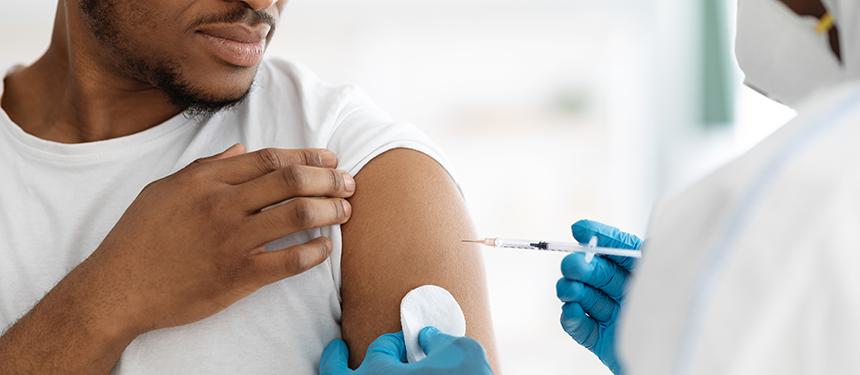Infectious disease and immunisation: lessons learnt?

In the first year of the COVID-19 pandemic, all our hopes for a “return to normal” lay in the race to develop vaccines. Within a record time of under a year we had vaccines that would prevent the worst effects of COVID-19, though eventually failing to prevent infection. Research continues into vaccines that will prevent infection and thus offer means for COVID-19 to transition from a pandemic to endemic disease, one that we can manage with prevention, treatments and public health strategies.
Forty-five years ago, the world witnessed the last natural case of smallpox thanks to a worldwide immunisation drive and the disease was declared eradicated - the only human disease for which that’s happened. The strategy used became to be known as ‘ring vaccination’, and it has since been used successfully in central and west Africa to control outbreaks of Ebola virus disease. Essentially, it consists of painstaking contact tracing, often in small villages, in order to identify tell-tale signs of disease. This is rapidly followed by interviews and detective work to trace all close contacts and map out an invisible network within the village society. The final action is then to vaccinate everyone within this network and consequently close an immunological loop around the group, thus denying the virus any further transmission chains within the village. This ring vaccination strategy uses fewer immunisation doses and requires fewer personnel than mass vaccination campaigns. But to be effective, it has to happen in a coordinated fashion across countries, continents and eventually across the world before a disease can be brought under control and eradicated, as smallpox was in 1980.
Before the COVID pandemic the World Health Organisation (WHO) and associated bodies were carefully tracking down the final pockets of wild polio disease in remote villages in Afghanistan and Pakistan, with a view to eradicating a second worldwide disease. However, the pandemic interrupted the immunisation campaigns and now polio virus is being isolated in wastewater samples in London, New York, Georgia and other US states as polio vaccination rates have dropped below protective levels.
Immunisation against monkeypox
Monkeypox virus is the latest infectious disease to be declared a public health emergency of international concern (PHEIC) by the WHO. More than 80 countries where monkeypox is not endemic have reported outbreaks of the viral disease, as confirmed cases reached over 27,814 and non-endemic countries – Brazil, Spain and India - reported their first deaths.
Drawing on experience with smallpox, the WHO and major governments, including Canada, the UK, and the US, have said ring vaccination is the preferred strategy for controlling the new epidemic. The strategy makes sense, hypothetically: compared to trying to vaccinate everyone, ring vaccination is a faster, cheaper, and a more targeted means of getting a pathogen under control. The question remains whether or not there's still time.
The virus spreads from one person to another during a close encounter, either the mucosal-membrane contact of sex or intimate skin-to-skin contact. It’s the same pattern by which sexually transmitted diseases spread, rather than the one-to-many distribution of airborne pathogens such as SARS-CoV-2 and measles.
Monkeypox, which causes painful pus-filled blisters, is not considered a sexually transmitted infection, but the current global outbreak has been linked to sexual behaviour. To the degree there is data, the majority of cases have been among gay or bisexual men who report having had multiple partners. So the ring vaccination strategy has been to vaccinate people who know or suspect they have been intimate with someone who developed monkeypox, or who had multiple sex partners in a place where monkeypox is known to be spreading.
Ring vaccination worked for smallpox because a person-to-person pattern of spread makes it possible to predict and interrupt chains of transmission, by vaccinating close contacts. However, it is not so easy with monkeypox - firstly you have to identify cases, then find likely contacts and then, crucially, have immunisation doses to administer. Each of these steps is proving complex in that some infections consist of single lesions, testing is patchy, many contact details are unknown and the supply of vaccines is limited. The fence, that ring vaccination is supposed to tighten around cases, is full of holes.
There are two vaccines potentially applicable to monkeypox: the old smallpox vaccine, which was stockpiled against potential bioterrorism, and a newer Danish vaccine with fewer side effects, but with severe supply constraints. As with COVID, there are enormous inequities in the distribution of the vaccine in high income countries and no immunisation available to endemic countries in Africa.
Vaccines need to be deployed where they are most effective, not to those who put their hands up first or can navigate complicated websites. They need to go to those at greatest risk of spreading the disease in a coordinated fashion as dictated by public health authorities. At this time where we are facing up to another debilitating worldwide disease, we need to use the scarce resources to the best effect to try to head off the next viral threat.
We don’t have anywhere near enough vaccines to go around and this will be the case for many months, if not years. We also have no coordinated international response to the disease. Monkeypox will get a lot worse before it gets better - we were not prepared for this known pathogen and we have not learnt from COVID. Until we are able to focus on diseases that are a threat, develop immunisations and stockpile them so that they can be distributed where they are most needed, we will continue to face epidemic after epidemic.



